Finding Black history resources for Early Modern History* (800 -1650 AD, Middle Ages Medieval time period) has not been easy. In fact, it’s been the toughest time period I’ve worked with so far. There are less resources – or at least they’ve been more difficult to find – and I am quite ignorant about this time period myself, so I wasn’t even sure what I was looking for in the beginning. But now that I’ve been digging in, I’m super excited to learn alongside my children next school year. Be sure to scroll all the way down for the reading schedule!
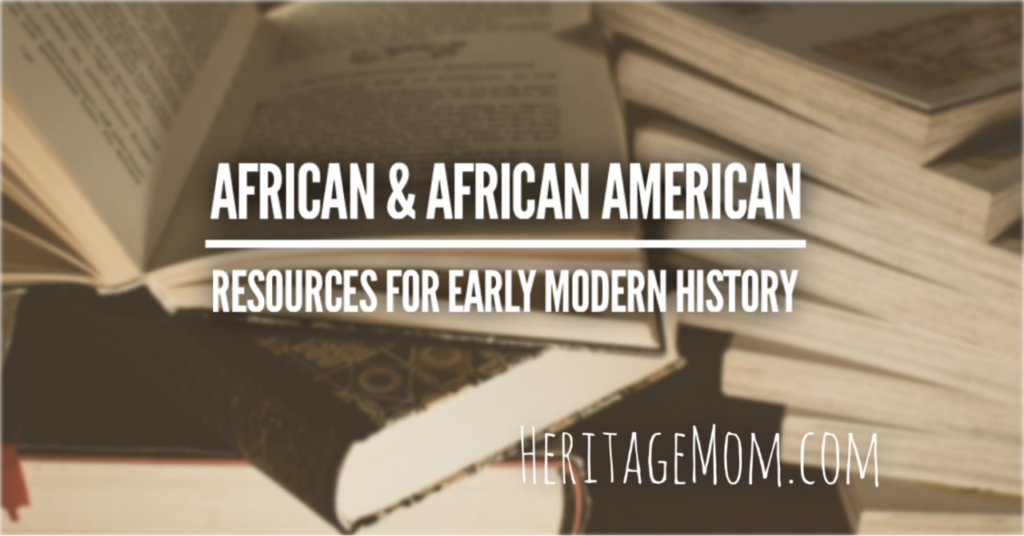
If you’re looking for black history resources for a Modern History rotation (late 1800’s – 1900’s), please check out Infusing Black History Into a Traditional Charlotte Mason Homeschool. Or you may prefer a gentle start with African American culture books for your early elementary children. Visit my Book Recommendations page for Black history posts for the other historical time periods. But if you’re already in the right place, grab a cup of tea, and let’s get to it!
Disclosure: As an Amazon Associate, I may earn commissions from qualifying purchases using these links, at no additional cost to you.
These are the African and African-American history books I’m planning to use for this time period:

The Royal Kingdoms of Ghana, Mali, and Songhay This one immediately caught my eye because it’s written by one of our favorite authors, Patricia McKissack, and her husband. Update: Redeemed Reader recently reviewed this book which I thought was pretty cool!
“The medieval kingdoms of Ghana, Mali, and Songhay grew rich on the gold, salt, and slave trade that stretched across Africa. Scraping away hundreds of years of ignorance, prejudice, and mythology the authors…reveal the glory of these forgotten empires while inviting us to share in the inspiring process of historical recovery that is taking place today.”
How I plan to use this book: We’ll cover part of this book over the course of the school year as I plan to read 4-5 pages a week aloud followed by written narrations. My 1a (2nd grade) child will listen in on the readings, but if he was my only or oldest I would save this book for later and read A Glorious Age (below) to him. Because my older kids will be reading A Glorious Age, my weekly readings from The Royal Kingdoms will focus on areas not covered in that book . Heads up: ***Page 75 discusses the risk of execution for premarital sex.***
“For well over a thousand years, from about A.D. 500 to 1700, the civilizations of western Africa flourished. Most of us know nothing about them. During the same period, Europe suffered from constant warfare and only slowly recovered its lost glory. The history of the “Dark Ages” and the Renaissance is taught in every school. Most of Africa’s history, except for that of Egypt, remains unknown to general readers.”
Patricia & Frederick McKissack, The Royal Kingdoms (emphasis mine)
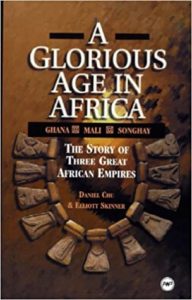
A Glorious Age in Africa: The Story of Three Great African Empires I first came across this book when I was searching for titles from Zenith Books, a former imprint under Doubleday aimed at African American youth, as I’ve had great success with those. The first edition (1965) of this book came up and I ordered it, but what I received was the edition republished by Africa World Press (1990). It was the seller’s mistake, but I went ahead and kept the newer paperback because it has the original text and illustrations.
“This book reveals the magnificent history and heritage of Africa, destroying, once and for all, the centuries-old, still lingering myth that Africa “was a continent without history.” Here is a fascinating account of the Africans from the 8th to the 16th century, highlighted by the successive rise of three Sudanese empires that at their height were the equal of any contemporary civilization in Europe or Asia.”
How I plan to use this book: My 2b (4th grade) and 2a (5th grade) children will have assigned reading from this book each term. Sometimes they’ll read it to themselves, and other times they’ll read it to me or each other. [Term 1: Ghana. Term 2: Mali. Term 3: Songhay.] They’ll do oral narrations after reading this book and written narrations after I read aloud from The Royal Kingdoms above.
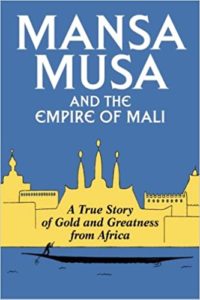
Mansa Musa and The Empire of Mali: A True Story of Gold and Greatness from Africa. The aforementioned books are quite text-heavy, so I chose this less dense biography to help round out our study. Mansa Musa is often described as the wealthiest individual of the Middle Ages (or in the history of the world), and he is about the only person covered in this entire time period that I was already familiar with. Sad, I know. Because of his fame, there are many Mansa Musa videos available on Youtube and BrainPop** to help add to your lessons.
“Oliver’s well-researched biography of Mansa Musa reads like an exotic tale of gold, glory, and adventure. During his long reign as Mali’s emperor, Mansa Musa led his empire into its Golden Age; presided over a spectacular, 60,000 person, 9,000 mile pilgrimage; founded a university in Timbuktu; and helped revolutionize architecture across the Sudan…Many of the African ancestors of today’s African-Americans came from West Africa. From 700 — 1600 A. D., one after the other, three great, black, commercial empires dominated West Africa…At its height, the Empire of Mali was the size of all of Western Europe. Well-crafted and fast paced, Oliver’s book is enhanced by a liberal sprinkling of enjoyable drawings, clear and helpful maps, and interesting photos.”
How I plan to use this book: I will read this biography aloud for my 1a (2nd grade) son towards the end of Term 2. My Form 2 daughters (4th & 5th grades) will have the choice to listen in or read it on their own, and they can choose either option each week. I offer this choice on some books because, while they can read it alone, I don’t want to turn them away while I’m reading to their brother if they just want to join us some days. Either one is fine with me. The weeks that they do read on their own, they’ll all narrate together so my son can hear his sisters’ narrations.
Update: If you’re trying to determine which book to go with, my children strongly preferred this book over the previous two.
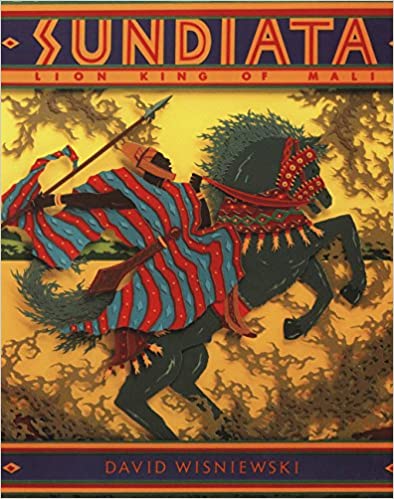
Sundiata: Lion King of Mali Sundiata was the founder of the Malian Empire, great-uncle of the more well-known Mansa Musa, and the basis of the Disney movie, The Lion King. How could I not include his awesome story in this year’s lessons? And yes, we’ll definitely pop some popcorn and watch the movie again, through a different lens, after reading this book.
“In the thirteenth century, Sundiata overcame physical handicaps, social disgrace, and strong opposition to rule the West African trading empire of Mali.“
How I plan to use this book: This is a brightly-colored picture book with full-page cut paper collages that I’ll read to my 1a son in Term 2. When I’m done witih it, I’ll casually leave it on the family room table, ensuring that my older kids will grab it without me assigning it. Don’t you love how that works?

Sundiata: An Epic of Old Mali. I chose this story because it’s written as a tale rich with dialogue and descriptive storytelling. I knew for sure that we were going to read about Mansa Musa, so I was hoping to zero in on a person from the kingdoms of Ghana or Songhay, but I just wasn’t able to find the right book. Despite so much focus on Mali in our plans, I’m still looking forward to reading this book.
“Retold by griots, the guardians of African Culture, this oral tradition has been handed down from the thirteenth century and captures all the mystery and majesty of medieval African kingship. It is the epic tale, based on an actual figure, of Sundiata (Sunjata). Part history and part legend, it tells how Sundiata fulfilled the prophesies that he would unite the twelve kingdoms of Mali into a powerful empire.”
How I plan to use this book: I haven’t decided whether I’m going to read this aloud to my older kids or assign it for them to read alone or aloud to me, but I’m definitely leaning towards reading it to them. It’s a story passed on through an oral tradition of storytelling, and I think I can help bring it alive if I read aloud. I see that this book is a lot more than it was when I purchased at $7.50 a few months ago. I’m not sure what happened so quickly. Maybe it’s now being included on a curriculum booklist that I’m unaware of?
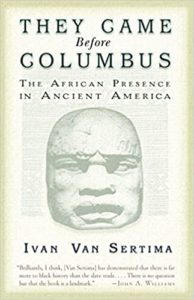
They Came Before Columbus: The African Presence in Ancient America. I picked this book because it’s intriguing, compelling, and highly rated. It’s a great addition to our home library that we can can pull from and return to over time.
“They Came Before Columbus reveals a compelling, dramatic, and superbly detailed documentation of the presence and legacy of Africans in ancient America. Examining navigation and shipbuilding; cultural analogies between Native Americans and Africans; the transportation of plants, animals, and textiles between the continents; and the diaries, journals, and oral accounts of the explorers themselves, Ivan Van Sertima builds a pyramid of evidence to support his claim of an African presence in the New World centuries before Columbus. In They Came Before Columbus, we see clearly the unmistakable face and handprint of black Africans in pre-Columbian America, and their overwhelming impact on the civilizations they encountered.”
How I plan to use this book: This book fascinates me because it has so many stories that I’ve never encountered in my entire education. I will read this book cover to cover in June/July so that I’m bathed in the information before I begin teaching this time period. As I read, I’ll highlight sections to read aloud to my children. I’ll be looking for areas that provide further detail to other people and events we’ll be studying and stories that will help bring this rarely-discussed element of history to life for them. Older students (high school or mature middle school readers) could be assigned this rich book to read through on their own. This is not a book that I could see any elementary students reading on their own, but older elementary kids that are used to this type of material likely won’t have any issues if Mom is reading. Please note: There is controversy surrounding the accuracy of some of this book. I still enjoyed it as a different/new perspective, but this is a heads-up so you can do a little research and choose for yourself before reading.
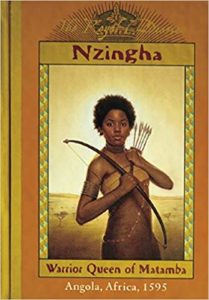
Nzingha, a part of The Royal Diaries series, is a fictional diary of a real female figure of royalty as a child. It’s a spin-off of the Dear America series, and we’ve thoroughly enjoyed some of those so I’m hoping to have similar success with these. [Side note: It’s also written by Patricia McKissack who wrote The Royal Kingdoms above and our favorite Dear America book, The Diary of Clotee, A Slave Girl.] This book will be scheduled for Term 3.
In fairness, I want to share that some Charlotte Mason moms don’t consider Dear America books to be quality living books. My opinion: All of these books are written by different authors, and I’ve found that the quality varies. That being said, sometimes it feels like we (CM mamas) speak disdainfully on any books that are fun. I think books can be quality AND fun…and isn’t it great when they’re both? For the record, I think this is a living book, and even if not, it’s most certainly a Life-Giving Book, and those play a significant role in our home.
“As the Portuguese slave traders find their way to the city of Angola in West Africa, young Nzinga, daughter of King Kiluanji, must face up to the dangers around her and find a way to help lead her father’s people through this tragic period.”
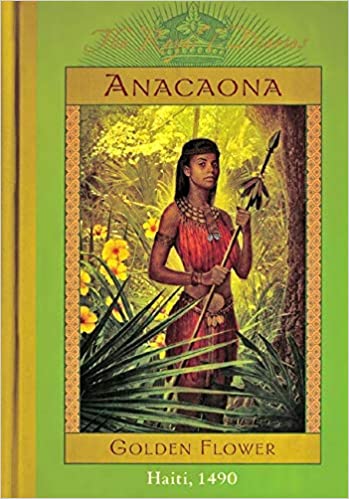
Anacaona, another book from The Royal Diaries series, was written by black Haitian-American author, Edwidge Danticat. Anacaona is quite an interesting historical figure. Native Americans consider her one of their own, yet she’s also hailed as a black or Afro-Carribean heroine. An academic paper on Anacaona is housed under the Oxford African American Studies Center by the Oxford University Press, but she’s also listed as a Native American we should celebrate instead of Columbus. I find many examples of this dual-identity online. I don’t know. She could be one or the other, but maybe she’s both. I’ll continue to do more reseach this summer, but I’m 100% just as happy to read this book even if she wasn’t black. After black history, Native American history is our most-studied and enjoyed history. And when my girls see the cover of this book, it’s going to be a wrap! She looks amazing.
“One of the greatest historical travesties is the lack of recognition and record of prominent figures from the indigenous North American people—especially women. In school, everyone learns about Christopher Columbus’ voyage, but few are fortunate enough to learn the history behind the Native American tribes that inhabited the land we stand on today.”
Dawn Day, 5 Amazing Indigenous Women To Celebrate Instead Of Christopher Columbus
“With her signature narrative grace, Edwidge Danticat brings Haiti’s beautiful queen Anacaona to life. Queen Anacaona was the wife of one of her island’s rulers, and a composer of songs and poems, making her popular among her people. Haiti was relatively quiet until the Spanish conquistadors discovered the island and began to settle there in 1492. The Spaniards treated the natives very cruelly, and when the natives revolted, the Spanish governor of Haiti ordered the arrests of several native nobles, including Anacaona, who was eventually captured and executed, to the horror of her people.”
How I plan to use both Nzingha and Anacaona: I’m thankful that my children adore historical fiction because the books end up feeling like dessert to accompany a good, healthy meal. Notice that I said dessert and not candy. Think of a luscious, decadent dessert – not cheap dime-store candy. The girls would read as many of these books as I find to put before them, and because they enjoy them so much, their tendency is to gobble. I provide them plenty of other free reads to do with as they please (gobble, gobble, gobble), but I schedule their historical fiction readings out because slow reading matters more than we expect. Anacaona will be read in Term 1 and Nzingha in Term 3.
Additional options (Updates!)
After writing this post, I added two more picture books to our history studies for this year:
In Mansa Musa, “Caldecott Medalists Leo and Diane Dillon capture the grandeur of Africa’s ancient empires, lands, and people in stunning paintings as this richly imagined tale of the boyhood of Mansa Musa, one of Mali’s most celebrated kings, carries us across the continent on a triumphant journey of self-discovery.” This book is out of print, but I was able to find a reasonably priced copy online several weeks ago.
Traveling Man tells of Ibn Battuta’s travels which are referenced in the books above. His recorded travels through the Malian empire have provided much-needed historical notes and given scholars a glimpse as to when Islam first began to spread into the heart of west Africa.
Another update: I’ve recently added some African history picture books along with the two books below covering pre-colonial African kingdoms to our home library, so I’m updating this post to include these additional titles:
African Beginnings by James Haskins and Kathleen Benson is a beautifully-illustrated picture book with a page or so covering various kingdoms as well as music and dance, art and religion, European trade, and slavery and colonization at the end. “From the ancient kingdom of Kush, whose Black pharaohs ruled Egypt for nearly a century, to the kingdom of Ghana…where more gold was traded than anywhere else in the world, to the legendary fifteenth-century metropolis of Benin, where houses made of red clay polished to such a high luster that it looked like marble, the African continent rang with a series of glorious civilizations that have had a lasting impact on the world’s history, and on American culture.”
African Icons by Tracey Baptiste is a newly-published chapter book that also has the most amazing illustrations. This book features sections on ten heroic figures whose vision built the continent and helped shape the world. Each profile features a portrait of the leader along with maps and other graphics. This book can be read aloud to lower elementary students, and older students can read it on their own. This a book that all children should experience whether they’re specifically studying this time period or not.
Reading schedule
Check out this fabulous reading schedule! Admittedly, I do not usually break out all of our readings by page number in the beginning of the year. I do it as I go along. Not because I think that’s a great idea but because I just haven’t found the time to do it all up front. And THAT is where having wonderful friends comes in handy! My friend, Laura, shares a passion for this work, and she has graciously agreed to share the reading schedule she prepared based off of my book recommendations.
Team work makes the dream work! Anacaona is not on here, but you can easily add it in to the blank biography slot for Term 1, if you’d like. The picture books are also not scheduled, so just drop those into your morning/afternoon read alouds or free reads for older kids. Early Modern Black History Plans
This is what I have planned so far, and I hope you’re able to find something useful from the research I’ve done for this time period. School hasn’t started yet, and we can certainly introduce new books within the school year, so please add to the conversation in the comments if you have ideas I haven’t listed.
Additional Notes:
*This time period corresponds to the following:
- Alveary (Charlotte Mason Institute) – Cycle 1 – 800 A.D. – 1650 A.D.
- A Delectable Education – 1000 to 1650
- Ambleside Online – Years 1-3,7,8
- Simply Charlotte Mason – Middle Ages/Renaissance/Reformation/Epistles and Early Modern/Epistles (The time period I’m covering is encompassed within these 2 rotations which span earlier and later when combined.)
**BrainPop This subscription includes extras like quizzes, worksheets, vocabulary, challenges, etc. Honestly, I’ve never looked at any of those things. I just play a relevant video during our school time when I find one that aligns with what we discussed that day. The videos cover Science, Social Studies, English, Math, Arts & Music, Health, and Engineering & Tech, and I find that we use the Social Studies section most (because…history). My kids LOVE these videos, and I like that it’s a subscription-based website/app with absolutely no outside ads. As always, you should still preview the videos for use with your family.
***“Amber, you seem to have plans to read several of these books aloud. Aren’t your older girls supposed to be reading their school books on their own by this age?” I hear you. Check out To Read Aloud, or Not To Read Aloud if you’d like to hear my thoughts on why I’m reading some of these books aloud to my older children.
Disclaimer: I have not read these books cover to cover. I’ll eventually pre-read some of them, but I can’t do it all at once up front. I normally don’t share books here until after I’ve read them, but so many of my online and in real life friends are covering the same historical time period in the fall, and they are planning right now. Please know that if I find something egregious within the pages of any of my recommendations, I’ll run back here and update the post. I don’t anticipate that happening though because I have all of the books sitting here with me, and I’ve done a pretty thorough preview of each one.
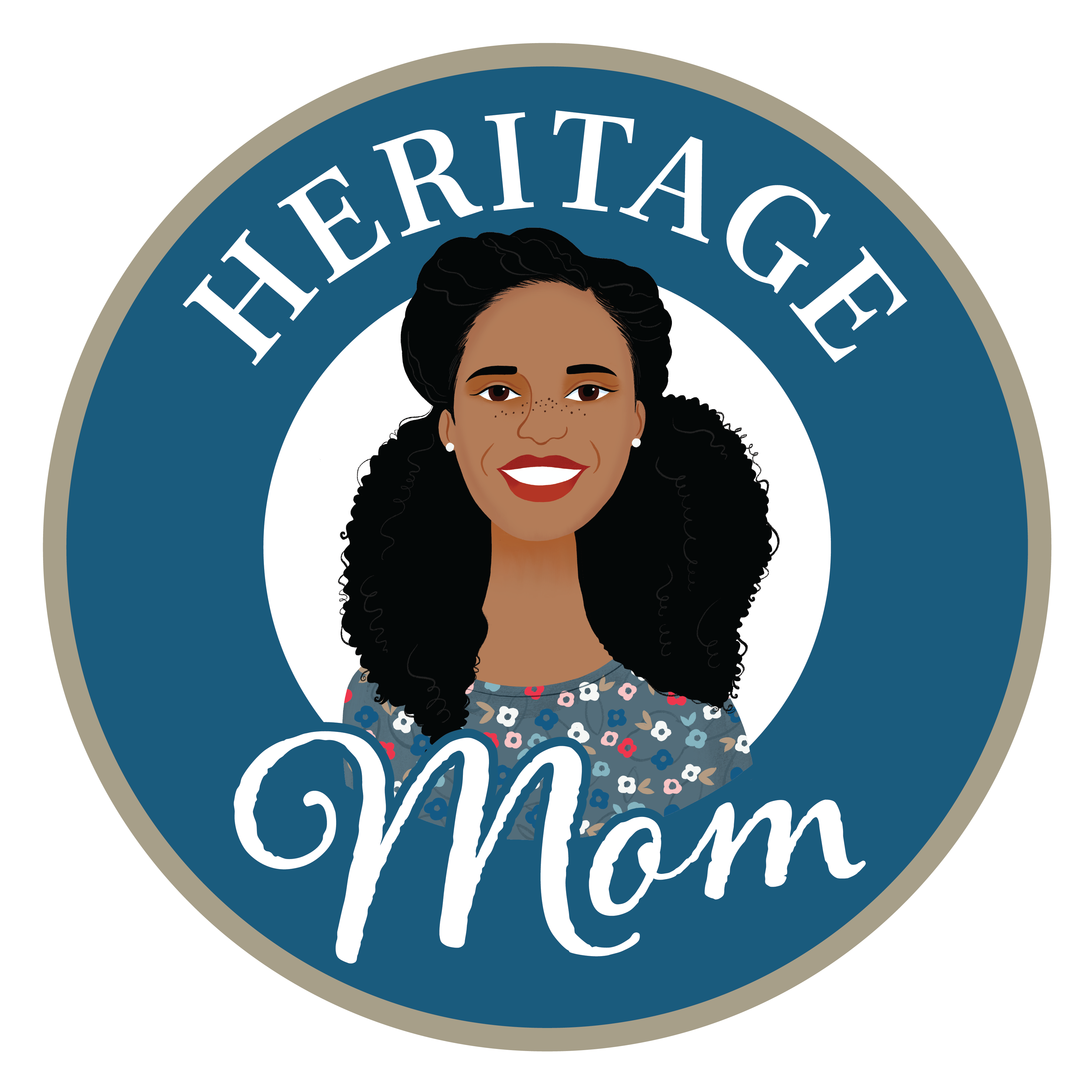






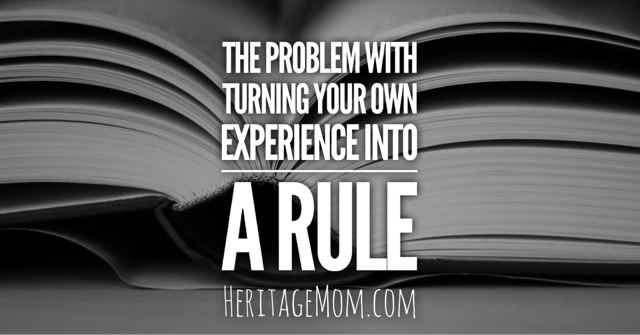
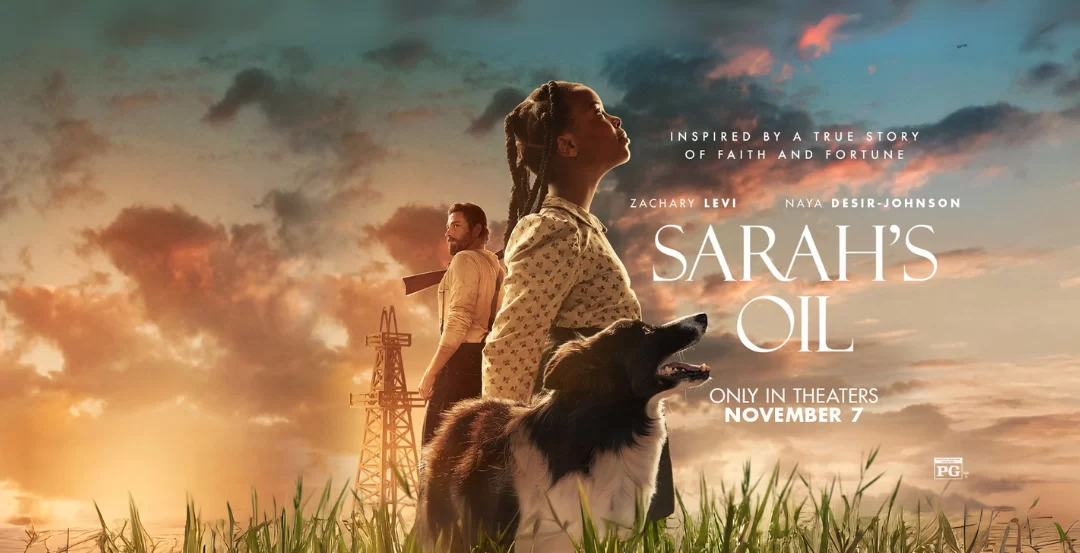

I am so thankful for this post! How do you fit these in throughout the week? Do they replace other history books? Do you still do other spines? I’d love a look at how you schedule each stream of history. Do you do history every day?
Great question! I prioritize these over other things, when necessary, because it’s one of the few topics my children will likely never encounter elsewhere until they become adult self-learners.
For the current school year, we did history 3x a week with 3 spines: 1 for traditional U.S. history (99% white), 1 for World history (90% white), and 1 for Black history. Our black history lessons also covered a lot about what white people were doing, but from the perspective of black people – totally different than most history books. We read the historical fiction in the afternoon & bed time (daily at one of those times…or both!). They read the biographies on their own 1-2x per week.
We’re adding Ancient history this year, so we’ll have a 4-day history rotation. If that proves to be too much, I’ll drop something else.
We definitely can’t do all the things! So far, I’ve always been able to fit a heavy dose of black history (and other cultures too) in, but sometimes other important things aren’t done as often as I’d like – solfa, drawing, nature journaling. Those ebb and flow, but I don’t miss the history lessons.
For me, black history is a non-negotiable. It’s ranked below Bible, of course. Then math. Then black history. So I find a way to make it work.
Do you write your own black history curriculum? If yes….
Lol, Laura! Well, yes and no. I select all of the books I want to cover, and then I break down the reading as we get to that book. So, it’s not likely that I’ll have a list of exactly which pages to read each week for all of the books up front, but on the back end, I’ll have a record of what we did. And the books will already be marked for when my other kids get to these books.
My methods are pretty simple though. For example, Anacaona has 181 pages. I want them to read it in Term 1, so I’ll divide the book by 11 weeks, and they’ll read approximately 16 pages a week. It’s a diary format with short entries vs. chapters so they can really start/end on practically any page. This summer while I’m prepping, I’ll go through the book, and mark “End Wk 1” and “End Wk 2” lightly in pencil where I want them to stop each week. And that’s it. So I never write it down anywhere. I just mark the book. And I’ll make sure that I assign the book on different days in each girl’s schedule since we’ll only have one book. We use small colored magnetic bookmarks so each person can keep place in the shared book.
For A Glorious Age, there are 3 chapters after the introduction which we’ll read together the first week. I want them to read 1 chapter per term (each chapter covers a different kingdom). Since the first chapter on Ghana has 38 pages, I’ll mark the book every 4 pages or so, depending on where there’s a more natural stopping point.
The Royal Kingdoms is also broken into 3 parts with each covering the same kingdoms as A Glorious Age, so it’s easy for me to break the reading down to match up with what the kids will be reading each week. To be honest, most families don’t need to do both books, but we’re going to because this is a major part of our history study and the authors present the info differently, often covering different aspects. The part on Ghana is 40 pages, so I’ll read up to 3-4 pages a week but only when the information adds to what they’re reading. I won’t duplicate the exact same thoughts.
Both books (A Glorious Age and The Royal Kingdoms) have pictures/photos and maps, so the weekly readings won’t take very long since some pages don’t have any words at all. Therefore, we can do both during 1 history timeslot. They can read AND I can read.
I’ll go on like that for each book at the beginning of each term. So I plan, but it’s done casually. I just back into what I want to complete for the term and split the pages up. These books aren’t long, so it works out well. If the readings were too long when I split them up, I would have to do something differently.
I hope this helps!
Thank you! This is perfect and very helpful! I’m planning to add this as its own history stream this year.
That’s awesome! It will be fun to compare notes with you.
Thanks for explaining how you scheduled this, I was wondering if I should work it into the pre-existing history streams or create another spine/biography stream. I appreciate all the work you put into explaining the process!
You bet! I really think you could do it either way. I’m going to try it this way, but don’t be surprised if I try it a different way next year, lol.
Amber, how was it adding in the separate history streams last year, particularly with your youngest? You said here you might do it differently next year, so I’m curious how it ended up going this way.
Still rejoicing over here… THANK YOU!!!
Woohoo! Still happy that you’re here 🙂
Would you mind sharing what your other spines are outside of the Black history suggestions?
Hi! I mostly use the Alveary curriculum for the other spines. I don’t want to list them here since that’s a core part of their curriculum, but you can find more info about their specific books on their YouTube channel and website: https://www.alveary.org/. I hope that helps!
Thank you for sharing your findings! It is very helpful and I look forward to sharing them with my children.
You’re welcome! I hope your family finds something they love here.
Yay! I have wanted a book(s) like this! I’m glad they are out there. I’m putting many on MY to-read list. 🥳 I have a goal to read the globe and this also helps with that goal too.
That’s an awesome goal, Summer! Have you seen the book “Give Your Child the World” by Jamie C. Martin? It has over 600 children’s book recommendations from around the world. It also has age recommendations and a description/summary of every book. I just love it.
Thank you for continuing to share resources you find! I’m gathering books & book ideas for when my children begin formal lessons and finding early African history is very challenging, specifically Kenyan/East African. (We live in Tanzania and are a Kenyan/American mixed family.)
You’re welcome, Carley! Yes, I’ve also found it more difficult to find East African books. I’m definitely going to keep my eyes open for books on Kenya, and I’ll let you know what I find.
I just read Mansa Musa – thank you for that recommendation. I also visited this website (shared in the Living Books for All Peoples FB group) which has biographies of Kenyans (!) and people from other African countries.
http://www.childrenslibrary.org/icdl/ResultByWorld?area=5&start=12&pgct=12&ilangcode=en&ilang=English&view=cover&sort=title&type=0&country=0
You’re quite welcome. This website looks very cool! Thank you for sharing because I always struggle to find books in that area.
What you’re doing is amazing. My husband and I have been searching for black history books to teach our children. This is very helpful. Thank you so much. Please keep sharing.
I’m glad that you’re finding useful things here. I appreciate you reading, and I will definitely continue to share.
Our son will be 2nd grade next year Form1A and we are using Alveary. Would They Came Before Columbus be a good book for him at this age? He is not reading much on his own from the main text- he just reads for reading.
We are supposed to use Leif Erikson by d’Aulaire and Stories of America along with a couple of pre-Columbus books. The history rotation is Cycle 1 for 2020-2021. I would like for him to get a complete historical perspective and I honestly never studied this part of history myself. We only talk about Africa in geography and our Bible readings. I have actually been wondering about getting Stories of America or something different. I have actually been waiting to order anything.
I don’t know as much true history as I should and so I struggle choosing books if I don’t go by what they give on the Alveary book lists. Thank you!!!
I understand! Most of us are not history buffs, and in fact, I hated history when I was growing up. Every step you take towards teaching your son well is progress. You don’t have to have all of the answers and the perfect books. They Came Before Columbus is definitely NOT a good fit for 1A. It’s much more appropriate for high school or advanced middle school students. I’ll be reading aloud some of it to my Form 2 children, but they wouldn’t be ready to tackle it on their own. For Form 1, I think either of the Sundiata books and the Mansa Musa book would be better. And don’t be afraid to use books that don’t match up perfectly with the time period. You could work through some of the books on my Early Elementary reading list along with the Alveary selections for a fuller perspective.
For some reason I was not seeing all of the comments to begin with and I was about to type out basically this exactly. We use AO, but my kids are also really young and I’m clueless about pretty much all history, so I’m learning right along with them. I think I may go with the Early Elementary reading and do Black history as read-alouds during teatime a couple of days per week. I’m already a little nervous about the coming school year because it’s the first year I’ll have 2 doing lessons, and then the toddler to occupy. I would rather them have an additional lesson that they look forward to, rather than an additional challenging lesson. We already do a mix of more modern biographies, so I’m not worried about sticking to the same time period for now. I think. Sometimes making homeschooling decisions is very freeing, and other times it’s overwhelming. 😂
Your plan sounds like a great one. It’s so important that we come up with realistic plans that will set us up for having joy-filled home education experiences. There’s no point in planning a perfect yet overwhelming situation. That would defeat the whole purpose! You know I know how you’re feeling! My opinion doesn’t matter, lol, but I think you’re on the right path.
Thank you for taking the time to respond. How do you go about finding these books? I need to also find books on Chinese people from a good perspective as my husband is Chinese (ie Gold Rush/Railroad/WWII) and there are some hard conversations there too, in American and World history, as well as my being Irish Italian (Ellis Island/Irish Potato famine/Irish and Italians in America) and our son being adopted with German decent (this one will be tough). We try to read about a variety of cultures all of the time. We can all trace our heritage to within two generations! My husband doesn’t have any family not born in China or HK. I feel lucky that I know this history and I want to teach it in a good way. Thank you for this resource.
I don’t have a specific way of finding the books, but I’m constantly reading and researching. I like to get recommendations from other trusted moms because it’s nice to have that “seal of approval,” but a lot of times I find things from searching on Amazon, used book stores, FB pages dedicated to living books, old articles, etc. Also, because people know that I’m into this, a lot of times they will just randomly send me book titles that they know I’ll appreciate. I also read books about books. One that you may really enjoy is called Give Your Child the World, and it has lists of children’s books by country. I just checked and there are ones from all of the countries you named. Most of these are stories vs. history books, but those are quite important as well. Another story book is Stories from Around the World from Usborne. It has a story from China and one from Germany – none from Ireland though. I hope this helps!
Wonderful resources!! Thank you so much for doing this work. I was just about to try and embark on it, and now I won’t need to! We are finishing up Island Story for this time period and Child’s History of the World, we also did Story of the World. We learned a lot from all of these resources, but now I want to explore what was going on in the rest of the world during this time. I also have the Usborne Medieval History book. Do you have that? I am not sure it could be classified as “living” but gives a good overview, jumping off point of different parts of the world and we love the pictures. Blessing!
I don’t have that one, but we do have the Usborne Book of World History and the Usborne Time Traveler books. I actually had completely forgotten about them, and I’m going to take a look to see what aligns with this time period. My kids think they’re fun, and I’m OK with that 🙂
Thank you so much for the work you’ve put into sharing this post. So happy to have your information and I look forward to incorporating some of these books next year!!
Thank you, Brooke. All of next year’s books are in a basket under my desk, and every time I look down there I get excited.
Wow! I’m a beginning homeschooling mama and am amazed by your ability to find these great resources! Your blog is a must read for me. Thanks for all that you do!
You’re so welcome, Katie. Finding and sharing is fun for me! I’m glad that you found me, and I hope that you’ll stick around 🙂
First of all, thank you so much for all your work, effort and insight that you share. This blog is so well done and a treasure trove and I so appreciate it.
Now, I guess I’m hoping for your take, as a veteran homeschool mom, on how to introduce history. We just finished year 2 with AO, which ends with Columbus. I injected additional Native American books and stories that I could in order to give a better sense of what was going on in North America before the European invasion (though none were truly ‘history’ and more glimpses of a few of the various cultures). Now I’m not quite sure what to do.
My problem is that I wasn’t able to wrap my head around living books and resources covering the kingdoms of Africa and South American (or better coverage of actual Native North American histories) to try and run parallel narratives of the time period for Y2 (1000AD to Middle Ages)- though have since read your post about African history and have acquired every resource you suggest (thank you SO much!). Seeing as African and South American (as well as Indigenous North American) history IS United States history, it feels really wrong to continue with all the atrocities and devastation that follows Columbus without covering at least some of the immense and grand history and cultures of South America and Africa (as well as more of the North American indigenous cultures). I agree with those more studied and eloquent than I who have stated that introducing African and South American indigenous peoples as enslaved and devastated people without the backdrop of their rich history and culture would only serve to inadvertently dehumanize these amazing people. I refuse to do this to our brothers and sisters of color- one of the reasons we homeschool. So, I guess I’m asking, from your experience of introducing history to kids (I’m starting my 6yo in AO Y1 and continuing with AO Y3 for my 8yo), would it be better to take the year off of AO history and try to cobble together North and South American Indigenous histories and African history through 1492 as our primary focus for this year, or would introducing these histories while continuing the history of the European expansion into North and South America (1400s-1600s) successfully and sensitively acquaint us with these many important peoples…? I’m not sure we could do them justice by attempting a two month summer history intensive before starting formal lessons towards the fall, but I guess that’s another option. Can you hint on what you found most successful for your history studies? I hope any of that that made sense…
I really could make a sound argument for doing either one of these, so I wonder which one would be easier or more comfortable for you right now? For me, the easier thing would be to continue with my original plan and replace some chapters or books from AO with chapters or books covering more of the Indigenous and African people of that time period. I would prefer to integrate them in – remove some but not all of AO to make room for some but not all of the other books. A blend would be my route. It wouldn’t take much – maybe make your way through one book per term on a different peoples group. You could alternate it with the AO reading, realizing that you won’t get through as much of the AO history plan this year and that’s totally OK. Or you can add a 20 minute history stream somewhere else in your week (which is what I do). Or you can assign a book as a free read (consider an audio version) that your kids can listen to during quiet time 1x per week. Whichever option you choose, be sure to pick something that will be a delight and not a burden because that will just stink for you as the year goes on. Please let me know if you have any other questions!
Thanks so much, I really appreciate it. I love the idea of an additional history stream added in. I’ll probably get a jump on this additional history stream over our mini summer break and continue on when we add everything else back in mid-August. You brilliant moms that have done this before are a God-send! (and I will be the first one here to click through when you get your affiliate links up- this is an immense amount of work and I would love to support you as much as I can, in additional to telling as many folks about your site as possible)
I’m glad that it helped! I actually did recently sign up for the Amazon affiliate program, so I do appreciate your support. I probably should have done it sooner, but I didn’t want my readers to think that there was anything influencing my recommendations other than my honest desire to help.
Thank you so much Amber! I’d been sensing from the Lord a change/addition was needed with our history. I’m a white mom with a gorgeous Ethiopian daughter (10), so I’ve been wondering/praying about giving her American, African, and African American/Black US history. Thank you thank you for your help with book recommendations. Thank you for encouraging a white mom with a black child. Blessings to you.
You are so very welcome. My oldest daughter is also 10, so I hope some of these books are literally right up her alley. I’m glad that you found my little space, and I hope you’ll stick around!
Thank you so much for these resources! I am just starting out with Charlotte Mason, and love her principles, but was concerned about how white/Euro-centric the curriculums seem to be. This page and all your hard work have shown me that I can give my children a more inclusive and accurate CM experience. Thank you!!
Yay! That is wonderful. You’re welcome for the resources, and I’m so glad that it helped you see how we can make this whole things work.
Hi,
I am an American living in the UK. We don’t homeschool, but I have found your booklists so helpful in searching out books that reflect the diversity of people on this earth. I wanted to let you know about some UK published books I found that might interest you. The Voices series, published by Scholastic UK, are middle grade novels featuring diverse voices from the UKs past. So far they have Roman Britain, Tudor, Victorian and WWII. There are some great books over hear the US never finds out about.
Hi Nancy! These look great. Thank you so much for sharing. You’re right, we don’t hear ANYTHING at all about books like this over here. I’m adding the link here in case others want to check it out too: https://shop.scholastic.co.uk/series/1456. Are there any other ones you’ve found that you love?
Many books have made it stateside, like Anna Hibiscus etc. There is a fairly new publishing house, called Knights of, which aims to be inclusive at all levels, both with the books and behind the scenes. The books are mostly too old for my 7yo still, but several have won awards. They also have a shop called Round Table Books, which stocks only inclusive books. I bet if you got in touch, they might have some new suggestions too.
http://knightsof.media/
https://www.roundtablebooks.co.uk/
Oh wow! I remember reading about the Round Table Books popup shop a few years ago. I didn’t know that they turned it into a permanent store. That’s really cool.
This is some great info. Thanks for sharing your world with us ❤️
This is our first year homeschooling… 9th grade boy. How would you suggest I incorporate African American history into his history routine? He is set to do World History this year. I think he has to have at least US History. Please correct me if I am wrong. As we gear up to start, I am feeling a little overwhelmed 😔 But, we are excited as well😇
Hi Shontrise! You’d have to check your state requirements to be sure, but in Georgia high school graduation requires World History, U.S. History, and Civics/Economics. To incorporate black history into his lessons, you can assign reading from a book that will carry him through the experience of African Americans over time. A lot of the ones I like are out of print, but you can still find used copies. I think something like The African American Family Album by Dorothy & Thomas Hoobler would be a good option. You can also have him read biographies about black people and read some historical fiction (novels) that cover significant events or people. These things would be in addition to his World History assignments, and the hours spent on them can be applied to his U.S. history credits. It’s totally OK for him to work on both streams of history simultaneously. I hope this helps!
This is incredibly helpful. I love your extra notes in how you use the books – it’s not just a list. Thank you so much!
You’re very welcome! I hope you find something enjoyable on the list.
Hi Amber – First, I want to send a HUGE THANK YOU for your website and sharing all of your incredibly valuable research and resources with us! I’m a CM educator and administrator at a wonderful Charlotte Mason private school and happily and regularly pass these resources on to our school’s curriculum director… I have been delighted to see our classroom libraries and curricula book lists rapidly expand in the past few years to include many wonderful books that beautifully reflect our brown and black brothers and sisters.
This year – in addition to many other hats – I have the joy of teaching a middle school history class, and we are including a study on Ancient Africa Kingdoms using many of these resources! I also found a lovely “spine” book that I’m going to use and thought that I would pass this along to you in case this is helpful to you as well. It’s from the Core Knowledge series and a sample of the teacher guide and student readers is available online: https://www.coreknowledge.org/free-resource/ckhg-unit-05-early-medieval-african-kingdoms/
(We will only use the latter half of the book on Ancient Africa.) This fits beautifully for us because it guides the students in a storytelling fashion, and includes the main historical figures that I wanted to make sure we included (Mansa Musa, Sundiata, Askia Muhammad, AND Ibn Buttata)… and then in addition we will read Mansa Musa Empire of Mali and Nzingha Warrior Queen, as well as a few read-aloud picture books (including Shaka Zulu and Mufaro’s Beautiful Daughters) – mainly because I’ve found in 6th grade both the kids and myself get a kick out of a random day of reading a picture book intended for Kindergartners! In fact, our main homework project for the unit will be for the students to create their own children’s picture book about their choice of one of these historical characters. 🙂
Hi Valerie! Thank you so much for sharing this resource and an overview of your plans. I LOVE hearing how others are working through this time period – especially the ancient African kingdoms. And I can’t agree with you more about the picture books. All of my children love them. Even my 11 year old shows no sign of tiring of our beautiful picture books so I’m keeping them coming. I really appreciate you coming back to let me know what you’ve been doing. If you run across anything else that you love, please don’t hesitate to come update here again. At the end of the school year, I’ll be doing another post that adds in a few things that I’ve found during the year that I didn’t have when I first wrote this post.
Your work here warms my heart so much, Amber! You are a blessing.
I am “African-French”, to use the American terminology, although I only carry my French passport. I was born in Mali, but graduated high-school in Dakar Senegal. I studied in elementary the African Empires, and Soundjata was one of the landmark books. Now that I live in the USA with French -English speaking kids, I am adapting our Ambleside Online CM curriculum to give the kids my whole Heritage. Finding this list is a great start for me. I am working on putting together a specific History and Literature curriculum for them including both African and French History and Lit, using the broad school programs I benefited from, both in Senegal, and in France. I would love to stay in touch with you, along the way! You inspire me so much!
I’m so glad that you were able to benefit from this list! Your educational and life experiences sound incredible, and it’s really wonderful that you’re working to bring those parts of your heritage into your homeschool. Yes, please do stay in touch. I’d love to learn more from what you find for your children and just follow your path in general.
Thank you for your reply, Amber. I follow you on IG, you can find me there under “multimomhomeschool”. I am just starting the journey, but I am planning to share everything I find with everyone there.
I am excited for the journey ahead! Love and blessings, Sabelle
Thank you so much for this list! We are wrapping up our Medieval studies and I came across this at just the right time! We had just learned about Mansa Musa, and I was able to get both of the fun historical fiction books and all of the picture books you recommended from our local library! Happy mama here:).
If you’re a happy mama then I’m a happy mama! That’s what this site is all about 🙂
Hi Amber! What did you think of They Came Before Columbus? We’ll be in this time period this upcoming school year.
Thank you!
Autumn Botts
I found this book fascinating, and it added so much to my personal understanding of the time period (and therefore what I could share with my kids). However, it’s 250 pages of small densely-packed text, and I would put it squarely in the high school and adult reading pile.
This is the book list I have been praying for!!
THANK YOU.
Have you seen this book about medieval Ethiopia?
https://www.smithsonianmag.com/history/new-history-changes-balance-power-between-ethiopia-and-medieval-europe-180978084/
You’re so very welcome! No, I definitely hadn’t seen that book before. It sounds really interesting though!
Thank you so much for listing these books! I love adding more books to our homeschool, especially diverse ones. There’s a saying that there are 3 sides to every story: his side, her side, and the truth. The only way we can get to the truth about the past is through seeing different sides to each story. I hope by adding more history books from different voices my children can have a more complete view of the world. I look forward to adding these to our AO schedule.
You’re so welcome! I think you’re wise to offer up varying perspectives (and missing voices!) to your children. Their education will be so much richer.
So many great resources!!! Thank you for sharing! Do you have recommendations for artist and music composers to study during this time period?
You’re welcome! I really wish that I did, but we actually studied diverse artists and composers outside of the time period because I could not find the resources needed to stay within the period.
Amber, thank you for these amazing resources. I know I can trust what you recommend. That being said, if you only had time to read a couple books to a lower elementary group of kids (K-2nd grade), from the lists in this blog post, which would you choose?
Great question! I would pick Sundiata: Lion King of Mali as my first choice and Mansa Musa by Khephra Burns as my second choice.
Hi! I am leaving CC for the first time in five years and going out on my own! I want to stick with the medieval time period this year for my 1st & 5th grader, but I want it to be COLORFUL! In addition to these books, do you have another curriculum that you use to give the other/typical perspective? I read where you said if you want a diverse curriculum you have to piece it together and I’m wondering what pieces of the renaissance/medieval period you include in addition to these amazing books.
Hi Amy! Congratulations on launching out on your own. I know that was a big decision, and I’m excited for you and your family. For history, specifically, I used A Castle With Many Rooms from Simply Charlotte Mason along with these books. Here’s the link: https://simplycharlottemason.com/store/castle-many-rooms/. Please let me know if you have any other questions!
Amber, I so appreciate your opinion on these reads! Some of these books I had already discovered and some were new to me. And we also love McKissack’s work! ❤️ I have a question for you, I want to integrate The Glorious Age & The Royal Kingdoms books into Ancient History for my oldest two (form 2a and form 3). We are covering Egypt and other Middle East regions (with Mills book) and I want to add Africa to this. These two books seem to cover the same 3 Civilizations. Are they the same time period? Or would using them both be redundant? Would one work better for my younger and one work better for the older? Thank you for letting me pick your brain a little. ❤️
These books correspond more to our American history/ European history time period, I’m realizing. I need to figure out how best to integrate this. How do you typically schedule your history? I’m assuming you add a stream or do this instead of or added to American (native American) history or something? I want to do this well so I’d love some guidance in how you’ve scheduled things!
And I found the reading plan…I missed it somehow the first time. 🤦♀️ So, you do this for your American stream – which makes total sense. Maybe instead of both books, I could use the plan for one book and sub in a native American spine for the other book then do a mix of bios and historical fiction from both. Now, I have to decide between them! 😳 I also have African Beginnings, so I’m going to add a few of those readings to our Ancient stream as well – Such as Nubia and others in that early time frame. 🙂
Any one of these books could be done in a single term, so you could do the Native American spine for the first two terms and then do one of these books for the third term as a lead-in for the next time period. You just need to decide whether you want to end the year with the middle passage or start the next time period with it so that there’s a bridge between these great African civilizations and colonial enslavement which is where many of the books for the 1700s will begin. So many different ways that you could approach this and none of them are wrong! Just don’t overwhelm the kids (and yourself) with too many books. That’s always the risk for me, so I have to really guard against it.
Hi Rachel! Yes, both books cover the same civilizations and time period. There was some redundancy between the two books, so I recommend choosing one or the other. I don’t regret doing both because we knew NOTHING of the time period in that area, and I felt like we had a really strong understanding after reading both books. There were certainly some things covered in one and not the other. But overall, I don’t think both are necessary for every family. They can easily both read the same book, and The Glorious Age was preferred by my children. It was a more engaging read than the McKissack book, but that doesn’t mean that the McKissack book wasn’t good. We enjoyed both!
Thank you for your reply! As I’ve perused them both, I was coming to the same conclusion as your children. I think I will have the McKissack available to my older two if they want to read it themselves or investigate more about what we are reading in Glorious Age. I don’t have a lot of knowledge of this time period in this continent either! I’m excited!
I also found a book called The Great Encounter (Piercy) which the author wrote for children after reading They Came Before Columbus (Van Sertima). I’m going to share that book with my kids and read Van Sertima’s book for myself. My husband did most of his history major courses in African history so he’s interested in reading it also. I also found this book, which you might be interested in – Medieval Ethiopian Kingship, Craft, and Diplomacy with Latin Europe (by Verena Krebs). I’m looking forward to checking it out myself!
You’re coming across a lot of goodies, and I LOVE that you took the time to come back here and share with me (us)! Thank you! I really hope that your family enjoys your exploration into this time period. I feel like 90% of what I learned was totally new to me which is wild.
I discovered a picture book in our library by Aire, Ekiuwa on Njinga and she also has one on Idia that I haven’t read yet.
Yes! Those are beautiful books. We own them, and I’ve shared them on social media before, but I need to add them to this post. Thanks for reminding me!
Just added Ekiuwa’s books here: https://heritagemom.com/2023/02/18/african-history-picture-books/ Thanks for the reminder!
Hi Amber! First, I want to tell you how much I appreciate all the effort your put into this list and the others! My almost 14yo daughter is biracial and I want to incorporate African American history into her AO curriculum. She will be doing Y7 in 24-25 but be in 9th grade, so my question is, what books would be best to add for her age? Would the “They Came Before Columbus” be the best for her age? Or should I start with the others and then do that one in Y8? I would like to continue using your lists for all of her high school years and we are really excited to add these books into our history stream! Thank you again for all the work you have done on these lists and finding these books!
Check your Instagram DMs. I replied there, but will give a quick answer here in case anyone else has the same question: I would have your 9th grader read the blue Mansa Musa book above. It will be much more engaging than They Came Before Columbus, which I’d list more as an adult book. Enjoy!
Hi Amber,
I have a daughter and son. My daughter is starting form 1a soon. Can you please share your history schedule for form 1a? We are African American, and I just want to be wise about how I begin history. I just want to follow your example! From a fangirl! Lol
So happy to know that you’re a fan, lol! When you say schedule do you mean which days & times and for how long I do history with my 1A? Or do you want to know what we’re reading? If you’re truly wanting to know more about my actual schedule, you can put “scheduling” in the search box and a couple of posts that I’ve written in the past about how we schedule our days should come up. If you’re more interested in WHAT we read for 1A, you can see the recommendations under each time period on the Book Recommendations page because they’re spread across multiple posts. Also, my 1A kiddo uses JOYFUL GENERATIONS Heritage Pack which is in my shop. I’d say that it’s probably the most important part of our history program for Form 1. Please take a look, and let me know if you have any questions!